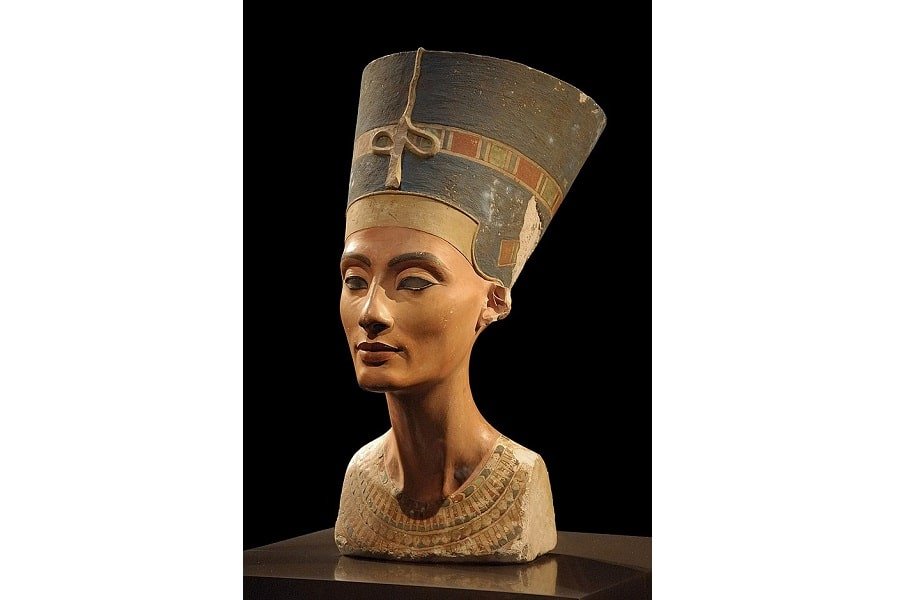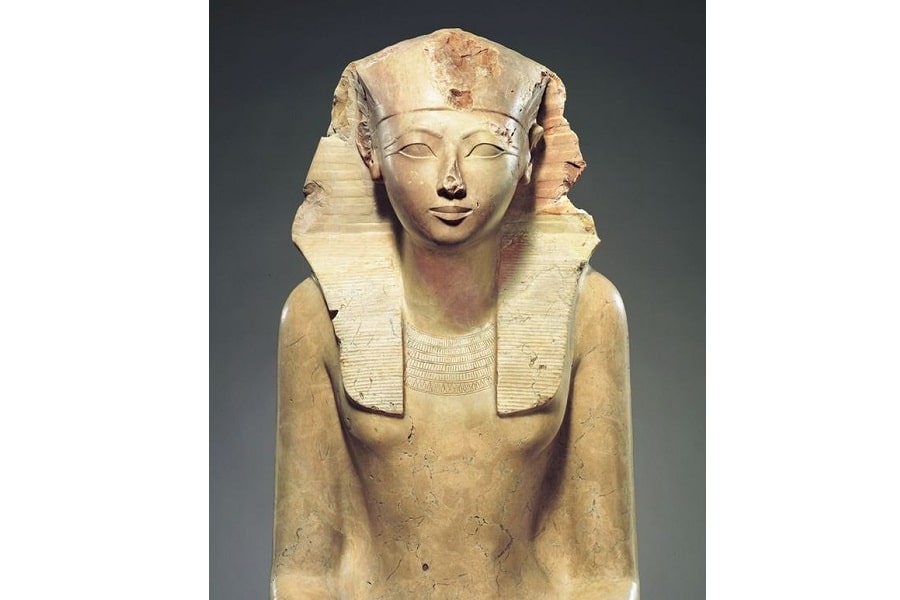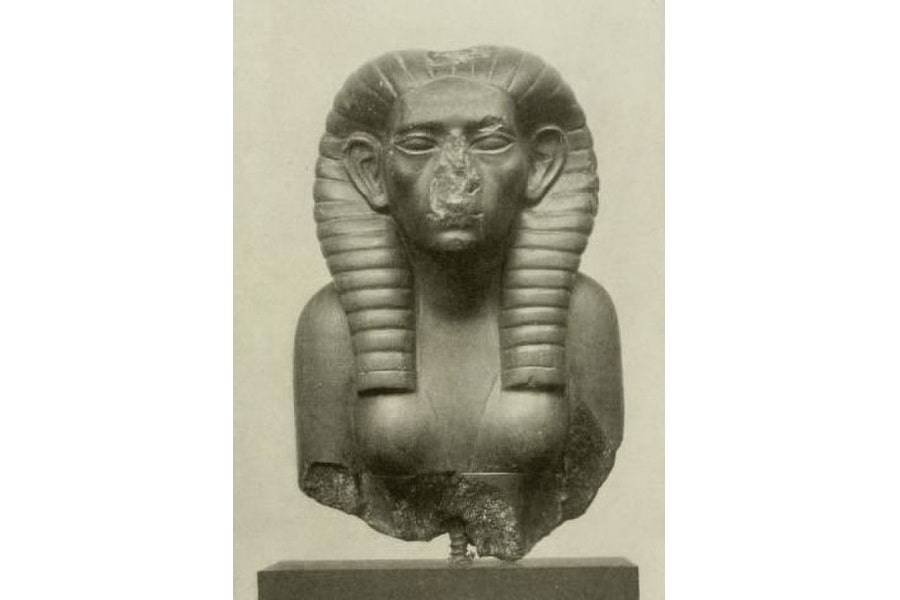Merneith, Nefertiti, Cleopatra, and a few other strong female figures are associated with ancient Egypt, one of ancient history’s most enduring and greatest civilizations. For 3,000 years the Egyptian empire was ruled by 170 great (some arguably not so great) pharaohs.
Of those 170 pharaohs, several of them were female. Ancient Egypt was ruled by a handful of powerful women, including Merneith, Nefertiti, and Cleopatra, each leaving their mark on the ancient world and history.
Table of Contents
Who Was the First Egyptian Queen?

Egyptologists are divided when it comes to naming the first female ruler of ancient Egypt to rule in her own right. Many believe that Neithhotep or Neith-hotep was the first female pharaoh during the First Dynasty of the Old Kingdom.
Some believe that Neithhotep was the wife of the first male pharaoh, Narmer, and not a female pharaoh. Others believe that Neithhotep may have become king while Narmer’s heir came of age.
Neithhotep was initially believed by historians to be a male ruler because her tomb was more aligned with male pharaohs. Later evidence was found that suggested Neithhotep was a female and the wife of Narmer.
The queen’s name has been found on several serekhs, which were usually reserved for the name of the king. This discovery has led many historians and Egyptologists to hypothesize that Neithhotep ruled Egypt in her own right and was in fact, the first queen of Egypt.
However, despite the evidence many scholars believe that the first female king of Egypt was Mernieth, who also ruled during the First Dynasty.
Merneith, the First Queen of Egypt

Queen Merneith is thought to have ruled Egypt from roughly 2950. It is believed Mernieth was a Great Royal Wife to Djet, and later ruled in her own right.
It is believed Merneith was of many female rulers because of the items found within the queen’s tomb, suggesting she was someone with great power. Additionally, her name was found on the clay serekh, like Neithhotep.
Queen Merneith was possibly the great-granddaughter of ancient Egypt’s first pharaoh of a unified Egypt, Narmer. It is thought that Mernieth was initially a senior Royal Wife of Djet, the fourth pharaoh of the First Dynasty. When Djet died, it is believed Mernieth ruled Egypt as regent until the pair’s son, Den, was old enough to become pharaoh.
Who Were the Famous Queens of Egypt?
Although each female pharaoh left their mark on ancient Egypt, some ancient Egyptian female rulers left a long-lasting impression. The most famous queens to reign over ancient Egypt are undoubtedly Queen Nefreteri and Cleopatra VII.
Nefertiti (1370 – 1330 BCE)

The bust of the ancient queen of Egypt, Nefertiti, is instantly recognizable today and has graced the cover of National Geographic and other magazines many times. Queen Nefertiti is regarded as being the most beautiful Egyptian queen with her beauty leading some scholars to believe she may have been worshiped as a fertility goddess.
READ MORE: 35 Ancient Egyptian Gods and Goddesses
Queen Nefertiti, whose full name was Neferneferuaten Nefertiti, meaning ‘the beautiful woman has come,’ was the queen of Egypt during the 18th Dynasty. This period is regarded as the golden age of pharaohs.
Nefertiti was the Great Royal Wife of the heretic Akhenaten, who was responsible for a religious revolution converting ancient Egyptian religion from a polytheistic belief system to a monotheistic one. Queen Nefertiti played an important supporting role during this time and agreed with her husband’s radical views.
Nefertiti had six daughters with Akhenten. When Akhenaten died, his son and heir, Tutankhamun, was just 2 years old, and therefore could not rule Egypt.
It is believed that Queen Nefertiti ruled ancient Egypt as regent while Tutankhamun came of age. Not much is known about Nefertiti or her time as pharaoh and scholars are unsure who her parents were. Despite this, her bust is the most widely produced piece of art from ancient Egypt.
Cleopatra VII (51 – 30 BCE)

Another legendary queen of Egypt is Cleopatra VII. She was the last pharaoh of Egypt and is undoubtedly the most famous female pharaoh to have ruled ancient Egypt. Cleopatra’s beauty is well documented by ancient historians.
She was a Macedonian Greek who was a queen from 51 BCE until 30 BCE, during the Ptolemaic Dynasty. The Ptolemaic pharaoh’s royal palace was in Alexandria.
How Did Cleopatra Become Pharaoh?
Cleopatra was the daughter of Ptolemy XII. Her family members were descendants of a Macedonian Greek general who served Alexander the Great. When her father died, his heir, Cleopatra’s brother, Ptolemy XIII, was just 10 years old, and could not yet rule alone.
Cleopatra had outlasted her two older sisters and so she became co-regent at the age of 18 and ruled Egypt alongside Ptolemy XIII. By the time Cleopatra and her brother were the rulers of Egypt, their empire included several territories in the Middle East.
Queen Cleopatra was the only Ptolemaic pharaoh to learn ancient Egyptian. Shortly after Queen Cleopatra and her brother became the rulers of Egypt, they had a disagreement which led her to flee from Egypt in 49 BCE.
The Ptolmiac queen did not want to relinquish the rule of Egypt to Ptolemy XIII, so she raised an army of mercenaries while living in the Middle East, to march into Egypt the following year and challenge him. The civil war between the two Ptolemaic rulers was fought on Egypt’s eastern Border at Pelusium.
Cleopatra and Julius Caesar
While Cleopatra and Ptolemy XIII’s forces were engaged on the Eastern border, Ptolemy welcomed Julius Caesar into the royal palace at Alexandria. The queen of Egypt wanted Julius Caesar’s help to take back Egypt from her brother. The queen is rumored to have snuck into the palace to plead her case to Caesar.
Caesar agreed to help the beautiful queen and defeated Ptolemy. Cleopatra once again became co-regent of Egypt, this time ruling alongside her younger brother, Ptolemy XIV.
Caesar stayed with the queen of Egypt for a while, during which time Cleopatra gave birth to a son whom she named Ptolemy Caesar, known to the ancient Egyptians as Cesarean. Caesar and the female pharaoh were never married.
Cleopatra, her son, and her brother all traveled to Rome to visit Caesar but returned to Egypt after Caesar’s murder in 44 BCE. Shortly after their return, Ptolemy was killed, and Cleopatra ruled alongside her son.

Cleopatra and Mark Antony
After the death of Caesar, a power struggle broke out in Rome. Mark Antony, one of Caesar’s allies (along with Octavian and Lepidus) asked the queen of Egypt for aid.
Cleopatra eventually sent help and Mark Antony was victorious. She was summoned to Rome shortly after to share her story of what happened after Caesar’s murder, and her role in it.
Cleopatra seduced Mark Antony and he promised to help her keep her crown and protect Egypt. Antony spent several months in Egypt between 41 and 40 BCE, following which Cleopatra gave birth to twins. Despite Anthony being married, she gave birth to another of Antony’s children in 37 BCE.
The pair caused quite a controversy when Antony decided to stay in Egypt and declare her son with Julius Caesar the rightful heir to Rome. Antony’s actions caused a war with Rome.

READ MORE: Roman Wars
The Death of the Last Queen of Egypt
The death of the last queen of Egypt, and the last pharaoh is a tragic tale that has become a legend. The couple was defeated by Rome in 31 BCE at the Battle of Actium. Cleopatra left the battle first, retreating to Egypt. Antony followed when he could.
While on his way back to Egypt, Antony was told the queen had committed suicide. Distraught, Antony took his own life before the news could be verified. As it happens, it was untrue.
After burying Mark Antony, Cleopatra actually did commit suicide with an extremely venomous snake called an asp. The death of Cleopatra marked the end of pharaonic rule in Egypt, and Egypt became a state of Rome.
Who Was the Most Powerful Queen of Egypt?
Nefertiti and Cleopatra were by far the most famed Egyptian queens, but neither was the most powerful. That honor goes to Hatshepsut (1479 – 1458 BCE), who was the fifth pharaoh of the 18th Dynasty.
Hatshepsut (1479 – 1458 BCE)

The female king, who was sometimes referred to as Maatkare, meaning king, was the daughter of Pharaoh Thutmose I. She married her half-brother Thutmose II, whom her father sired with his second wife (the ancient Egyptians practiced polygamy and incest).
During her time as a Royal Wife, Hatshepsut was given the title of God’s Wife of Amun, which was the highest honor a woman could receive in ancient Egypt. This title gave Hatshepsut power before she became the king of Upper and Lower Egypt.
When Thutmose II died, Hatshepsut ruled alongside her stepson, Thutmose III. It was during her time as regent that Hatshepsut decided that she would become pharaoh in her own right and assumed the royal titles of the pharaoh. She became a co-ruler, rather than a regent.
While pharaoh, Hatshepsut continued the pharaonic tradition of building and built many monuments. Some of her impressive building projects are the Mortuary Temple of Hatshepsut situated in Deir el-Bahari, the Red Chapel, and the Speos Artemidos.
The reign of Hatshepsut is regarded as being a time of peace, prosperity, and stability, she also had the longest reign out of all female leaders.
Hatshepsut in Ancient Egyptian Art
During the early years of her reign as regent, Hatshepsut appears as a woman in art but later changed her appearance to align with that of a male pharaoh in ancient Egyptian art.
In statues and reliefs, Hatshepsut is shown wearing a false beard like that of a male pharaoh and is often shown wearing the clothing of a male pharaoh. Despite being shown as a male, Hatshepsut was still referred to as a female.
After her death, Thutmose III and his son Amenhotep II tried to remove all mention of Hatshepsut from the historical record.
Mention of the female king survived, in secluded areas where they would not be easily found. The Egyptians believed that if you remove someone from history by removing all mention of them, they could not enter the afterlife.
Who Were the Four Queens of Egypt?
Several female rulers reigned during each period of ancient Egypt’s history, many of which have been lost to history or are disputed. Hatshepsut is one of four women that we know for certain were female pharaohs. In addition to Hatshepsut, Sobekneferu, Neferneferuaten, and Twosret ruled in their own right.
Sobekneferu (1806-1802 BCE)

Sobekneferu, who is also known as Neferusobek, Nefrusobk, or Sobekkara, ruled during the Middle Kingdom Period, and was the last pharaoh of the Twelfth Dynasty.
Queen Sobekneferu became a female pharaoh after the death of Amenemhat IV. Her rule as a female king of Egypt is recorded in several places, including a list of kings at Karnak and features on the Saqqara Tablet, which is a stone tablet engraved with a list of pharaohs.
Queen Sobekneferu’s relationship with Amenemhat IV is unclear. He was her half-brother but may have also been her husband, although she is never referred to as ‘Kings Wife.’
Either way, she did not ascend to the throne based on her relationship with the previous pharaoh. Sobekenefru became pharaoh by claiming she was co-regent with her father, Amenemhat III.
Queen Sobekneferu was the first queen of Egypt to adopt the full royal titulary. She was also the first ruler to associate herself with the crocodile god, Sobek. The cult of the crocodile god was gaining prominence during this period.
The kings of the Twelfth Dynasty cared for crocodiles at their religious center of Fayoum. Several rulers after the female king took a name inspired by Sobek.
What Happened to Sobekneferu?
Queen Sobekneferu ascended to the throne at a time when Egypt was in decline. The female pharaoh did not rule Egypt long. Her reign lasted 3 years, 10 months, and 24 days according to the Turin King List, on which she is also mentioned, which is the most complete list of Egyptian kings discovered so far.
We do not know what happened to Queen Sobekneferu, nor do we know the location of her final resting place, as her tomb has never been discovered.
Neferneferuaten (1334-1332 BCE)
Neferneferuaten was a female king who was the king of Egypt towards the latter half of the prosperous 18th Dynasty. Neferneferuaten’s full royal name was Ankhkheperure-Merit-Neferkheperure.
The ancient queen’s birth name is Neferteri-Neferneferuaten or Neferneferuaten – Nefertiri, leading some scholars to believe that Neferneferuaten and Nefertiri are the same person.
Neferneferuaten reigned towards the end of the Amarna Period. This period was when the pharaohs of Egypt ruled from Akhenaten, or what is now Amarna. Neferneferuaten ascended to the throne after the short-lived reign of the male pharaoh, Smenkhkare, after the death of Akhenaten.
The line of succession after Akhenten is unclear, with both Smenkhkare and Neferneferuaten acceding to the throne within a short period. Initially, Egyptologists believed that the two rulers were the same person, but this has since been disproved as evidence has been found that indicates Neferneferuaten was a female.
Neferneferuaten was not buried in a tomb fit for a king, many of the funerary items that were intended for the female pharaoh, wound up in someone else’s tomb.
Neferneferuaten and Tutenkhamun

Clues about the female king Neferneferuaten were found in the tomb of ancient Egypt’s most famous male pharaoh, King Tutankhamun.
Several items were found in the young king’s tomb that seemed to be originally meant for a female, some items were even inscribed for Neferneferuaten. For example, the canopic jars that held King Tut’s internal organs were distinctly female.
Perhaps the most intriguing clue of all from King Tut’s tomb is the fact that the name Ankhkheperure was found partially removed from the boy king’s funerary mask.
The reuse of the female rulers’ funerary items provides possible scenarios about the female king’s downfall. The evidence suggests that she was overthrown.
Twosret (1191-1189 BCE)

Tworset was the last pharaoh of the 19th Dynasty and was the Great Royal Wife of Seti II. Twosret became co-regent of Egypt with Seti II’s son and heir, Sipta. It is believed Sipta was the son of one of Seti’s other wives. The young prince died just 6 years into his reign and so Twosret became the sole ruler of Egypt for two years.
Twosret is believed to have been the daughter of the fourth pharaoh of the 19th Dynasty, Merneptah, and the princess Takhat. When Twosret took the throne her title became Daughter of Re, Lady of Ta-merit, Twosret of Mu.
According to the first pharaoh of the 20th Dynasty, Setnakhte, the reign of Twosret ended in a bloody civil war. The end of the 19th Dynasty is described as chaotic. Rameses III excluded Twosret’s name from the Medinet Habu list of Egyptian kings.
Twosret was buried in a tomb with Sett II, but Setnakhte moved the couple and replaced each depiction of Twosret in the tomb with his own.
What is an Egyptian Queen Called?

The ancient Egyptian queens who ruled the land as pharaohs were not given a different name. The queens of Egypt who ruled in their own right are not to be confused with the wives of the male kings, who were known as the Great Royal Wife.
The Egyptian queens came to power as co-regents. This means that when women ruled the world, as Egyptologist Kara Cooney so aptly put it, they did so only until a male heir ascended to the throne.
How Many Queens of Egypt Are There?
The question of exactly how many female pharaohs ruled ancient Egypt is a difficult one to answer. Generally, the pharaonic line was passed on through the male line, however, sometimes a woman would find herself ruling Egypt.
The reason it is so difficult to say exactly how many female pharaohs ruled the ancient Egyptians as head-of-state is that often, when a male pharaoh came to power after the reign of a woman, her reign was usually erased from history.
READ MORE: Ancient Civilizations Timeline: 16 Oldest Known Cultures From Around The World
Egypt had many powerful queens or consorts who were Great Royal Wives to the male pharaohs, but there were also several, who ruled as king outright. History only remembers a few of these powerful women, and even then, there is debate amongst scholars as to whether or not they were in fact, female kings.
Kara Kooney hypothesizes that women ascended to the throne in ancient Egypt during times of turbulence and were allowed to rule to maintain social order. Although powerful, female queens ruling as kings were merely placeholders.